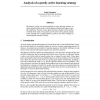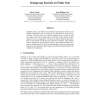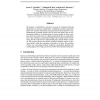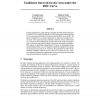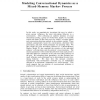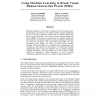103
click to vote
NIPS
2004
15 years 2 months ago
2004
act out the core search problem of active learning schemes, to better understand the extent to which adaptive labeling can improve sample complexity. We give various upper and low...
NIPS
2004
15 years 2 months ago
2004
Complex objects can often be conveniently represented by finite sets of simpler components, such as images by sets of patches or texts by bags of words. We study the class of posi...
106
Voted
NIPS
2004
15 years 2 months ago
2004
In this paper we show that it is possible to model sensory impressions of consumers about beef meat. This is not a straightforward task; the reason is that when we are aiming to i...
96
Voted
NIPS
2004
15 years 2 months ago
2004
We propose a probabilistic, generative account of configural learning phenomena in classical conditioning. Configural learning experiments probe how animals discriminate and gener...
105
click to vote
NIPS
2004
15 years 2 months ago
2004
In many applications, good ranking is a highly desirable performance for a classifier. The criterion commonly used to measure the ranking quality of a classification algorithm is ...
NIPS
2004
15 years 2 months ago
2004
We provide a principle for semi-supervised learning based on optimizing the rate of communicating labels for unlabeled points with side information. The side information is expres...
114
click to vote
NIPS
2004
15 years 2 months ago
2004
Theories of access consciousness address how it is that some mental states but not others are available for evaluation, choice behavior, and verbal report. Farah, O'Reilly, a...
100
click to vote
NIPS
2004
15 years 2 months ago
2004
In this work, we quantitatively investigate the ways in which a given person influences the joint turn-taking behavior in a conversation. After collecting an auditory database of ...
136
click to vote
NIPS
2004
15 years 2 months ago
2004
We show how to build hierarchical, reduced-rank representation for large stochastic matrices and use this representation to design an efficient algorithm for computing the largest...
113
Voted
NIPS
2004
15 years 2 months ago
2004
Machine learning is often used to automatically solve human tasks. In this paper, we look for tasks where machine learning algorithms are not as good as humans with the hope of ga...
